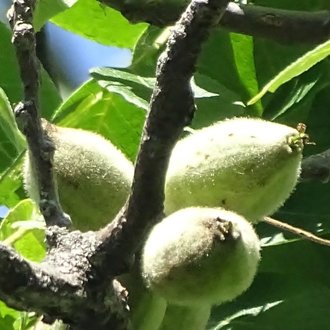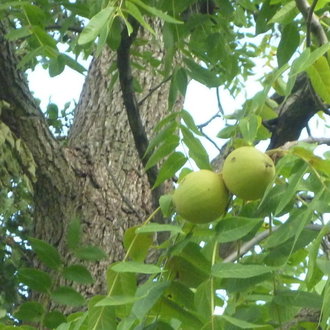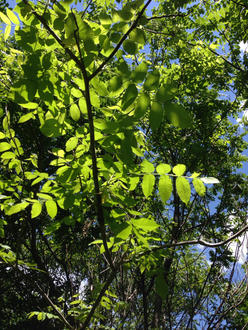Butternut (Juglans cinerea L.)
Also known as white walnut.
↑Summary
A tree native to eastern North America, mostly found on well-drained slopes; dying back due to a canker disease.
↑Range - Expand
| Legend | Color |
| Native | |
| Native or Not Present | |
| Introduced or Not Present | |
| Introduced |
This tentative map is based on our own research. It may have limited data on Canada and/or Mexico, and there is some subjectivity in our assignment of plants as introduced vs. expanded. Read more in this blog post.
Although this plant occurs somewhere in each of these regions, it may only occur in a small part of some or all of them.
↑Similar Plants
↑Habitat
Found mostly in coves, stream terraces, and on slopes. Limited to well-drained sites, but found both on deep, nutrient-rich soils and on poorly-developed, dry, rocky soils, such as talus slopes, especially those made of limestone.
Usually uncommon, occurring only as isolated trees, and found in a variety of forest types; most common in mixed mesophytic forests.
↑Life Cycle
Seedlings develop a taproot, but the taproot is less pronounced, and the root system more fibrous overall, than in the closely-related black walnut. On sites with rocky, poorly-developed soil, trees may not develop a taproot at all. Growth is rapid. The root system is wide-spreading, and also deep where soil allows.
Seedlings can tolerate some shading from the side, but need sunlight from above in order to survive.
Trees usually begin producing seed around 20 years of age, with production peaking between 30 and 60 years. Good seed crops are produced every 2-3 years, with lighter crops in between. Due to the uncommon nature of this tree in many habitats, failure to pollinate successfully is often a limiting factor in seed production. Seeds are distributed primarily by squirrels and also by other animals and by gravity.
Seeds germinate underground in the spring following distribution.
Trees rarely live beyond 75 years.
↑Faunal Associations
The seeds are particularly attractive to squirrels and other animals.
A number of insects eat this species, many of which also eat related trees. The tree supports wood borers, lacebugs, husk flies, and bark beetles, and weevils also eat the nuts. The insect that is most damaging to the tree is the butternut curculio (Conotrachelus juglandis).
↑Uses
This species is consumed for its nuts. Although the shells of wild trees are rather difficult to crack, several cultivars have been developed which have easier-to-crack shells and otherwise desirable nuts.
This species has also been used for wood, although its use is declining due to the decline of the species as well as it being protected in Canada. The wood is lighter in color and softer than that of black walnut. Its softness can make it prone to having fuzzy surfaces when sanded or cut. Besides this it is easy to work with. It is used in veneer, furniture, interior trim, boxes and crates, and for carving.
↑Related Plants
Several Juglans species are found throughout North America; of these, only the black walnut, J. nigra, is common and widespread. Where the ranges overlap, the black walnut is usually much more common. These species have not been confirmed to hybridize, but butternut can hybridize with several non-native species, and some of these hybrids have established in the wild in North America.
There are also a few locations where the Japanese walnut (J. ailantifolia) or English walnut (J. regia) have become established in the wild.
↑Notes
This species has been threatened and greatly reduced by butternut canker (Ophiognomonia clavigignenti-juglandacearum), a pathogen of unknown origin that begin spreading from Wisconsin. The nature and origin of this disease is poorly-understood; it was originally thought to be caused by Melanconis juglandis but later was found that this species only caused a secondary infection and was not able to kill trees on its own. This disease was first described in 1923, but descriptive reports of a similar decline were reported earlier. One theory is that the pathogen entered the U.S. on nursery stock of the Japanese walnut (Juglans ailantifolia).
This disease has greatly reduced this once common species in extent and numbers, leading it to be considered endangered. It has not killed trees quite as thoroughly as the chestnut blight, but the species has been essentially eliminated from parts of its range, including North and South Carolina.
↑Links & External Resources
• Butternut | The Wood Database (About This Site)
• Butternut | Fire Effects Information System (FEIS) (About This Site)
• Juglans cinerea (Butternut) | USDA PLANTS Database (About This Site)
• Juglans cinerea | Go Botany (About This Site)
• Juglans cinerea (Butter Nut) | Missouri Botanical Garden Plant Finder (About This Site)
• Butternut | Virginia Tech Dendrology Factsheets (About This Site)
• Butternut | Silvics of North America (About This Site)
• Juglans cinerea | Biota of North America Project (BONAP) (About This Site)
• Juglans cinerea | NatureServe Explorer (About This Site)
• Juglans cinerea | Flora of North America (About This Site)
• Butternut | Maryland Biodiversity Project (About This Site)
• Juglans cinerea L. (Butternut, White Walnut) | Digital Atlas of the Virginia Flora (About This Site)








